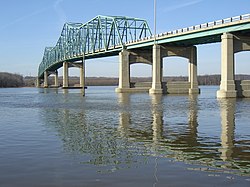Lacon Bridge | |
|---|---|
 Crossing over the Illinois River at Lacon, Illinois | |
| Coordinates | 41°01′32.43″N89°25′00.28″W / 41.0256750°N 89.4167444°W |
| Carries | Two lanes of Illinois Route 17 |
| Crosses | Illinois River |
| Locale | Lacon, Illinois |
| Official name | Lacon Bridge |
| Maintained by | Illinois Department of Transportation |
| ID number | 000062000314852 |
| Characteristics | |
| Design | Continuous truss bridge |
| Total length | 1,573 feet, 378 feet at its longest span |
| Width | 2 traffic lanes, 26 feet (7.9 meters) |
| Height | 60 feet above water, 500 feet above sea level |
| Longest span | 114 m |
| History | |
| Opened | 1939 |
| Location | |
 | |
The Lacon Bridge crosses the Illinois River in the community of Lacon, Illinois. Built in 1939, it is one of the oldest crossings of the Illinois River. [1]